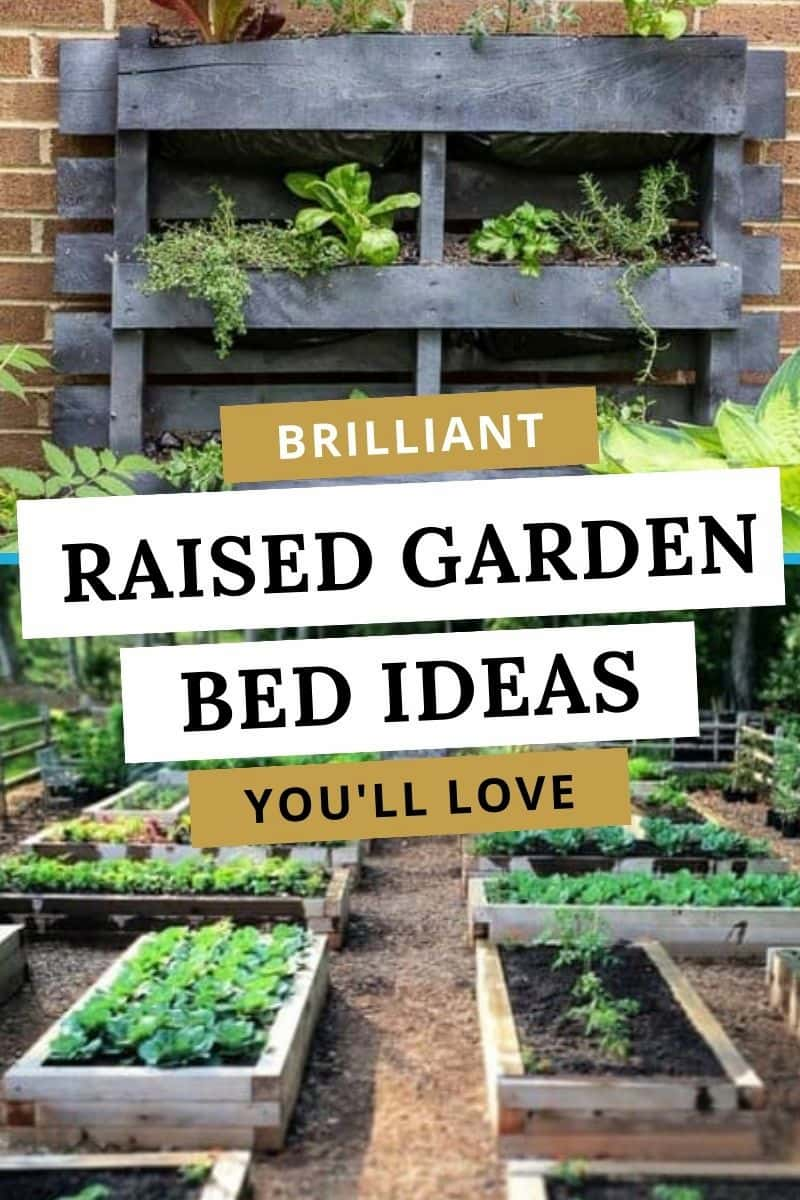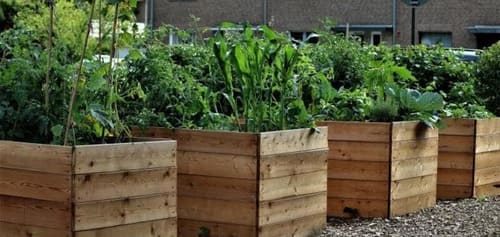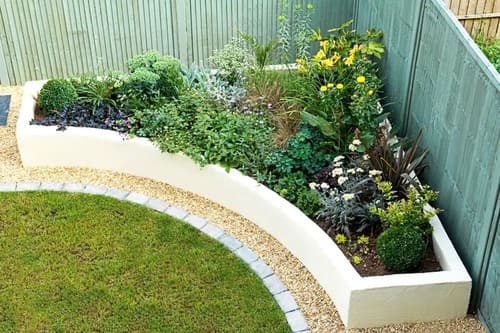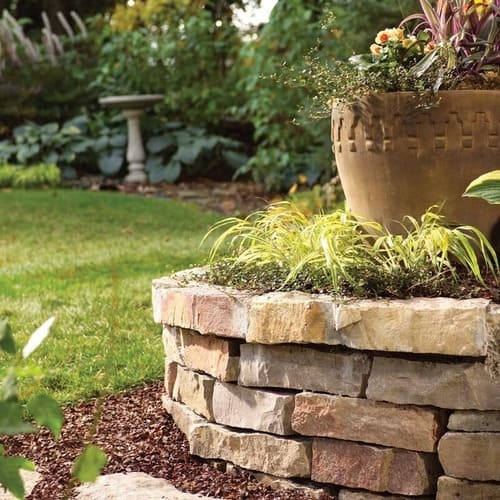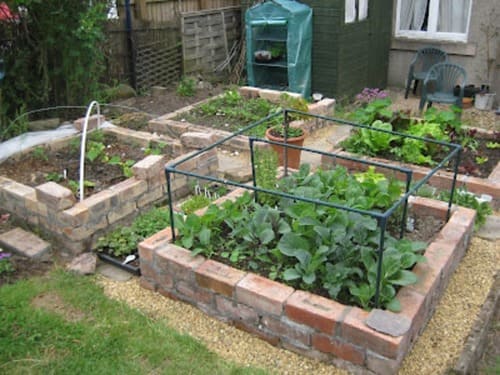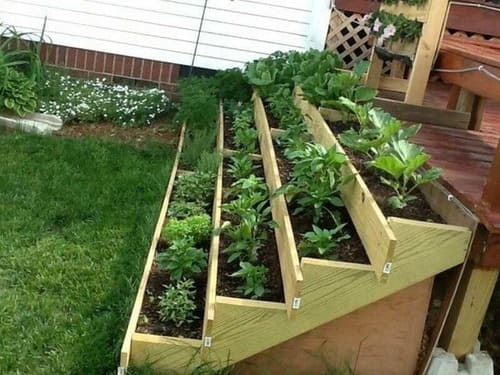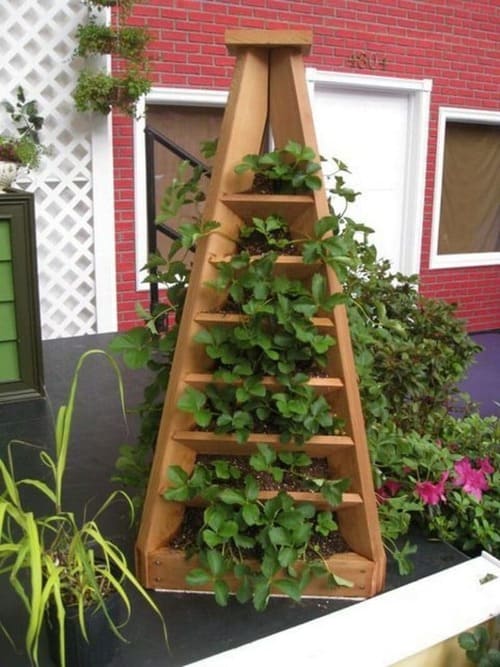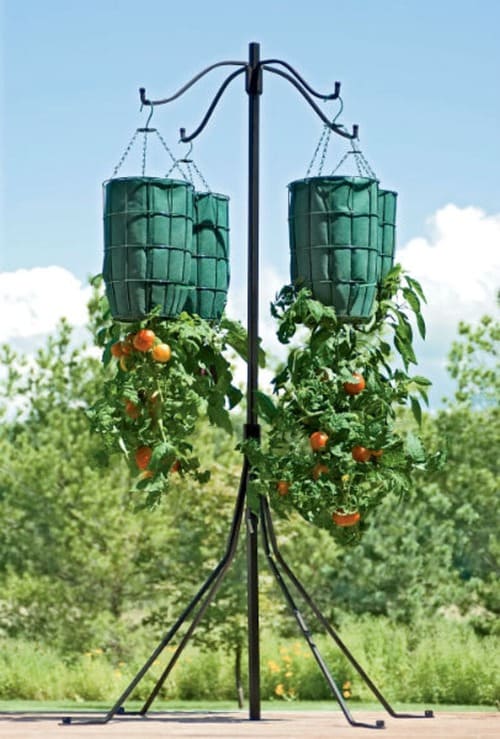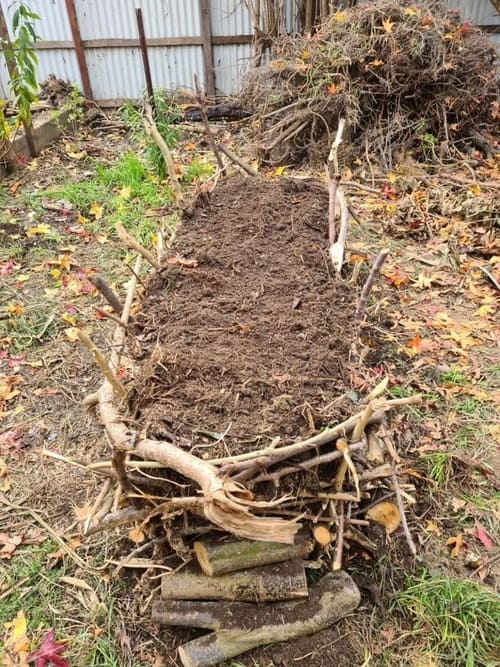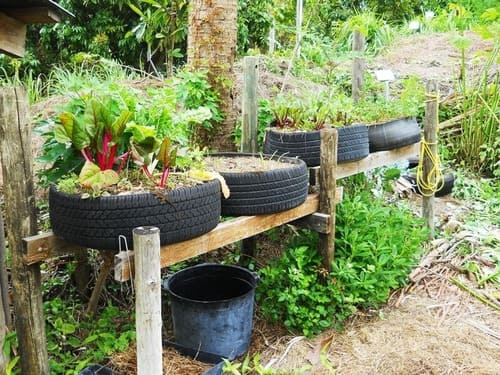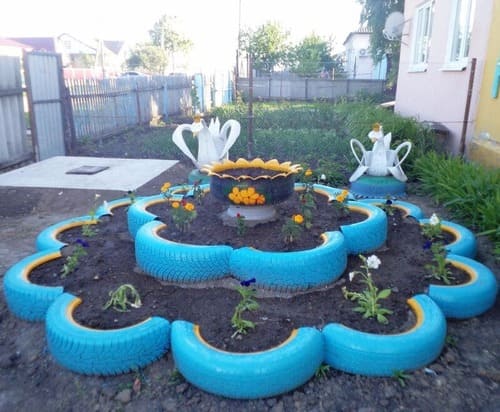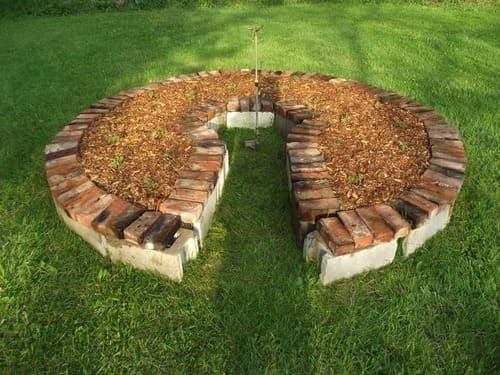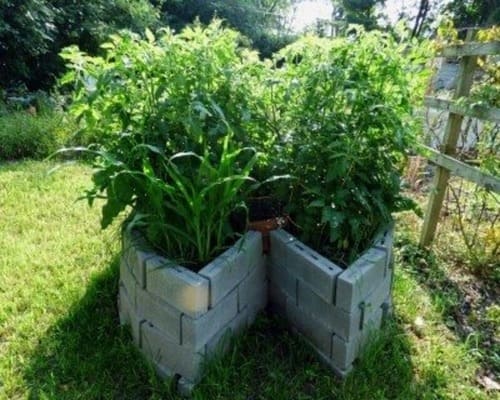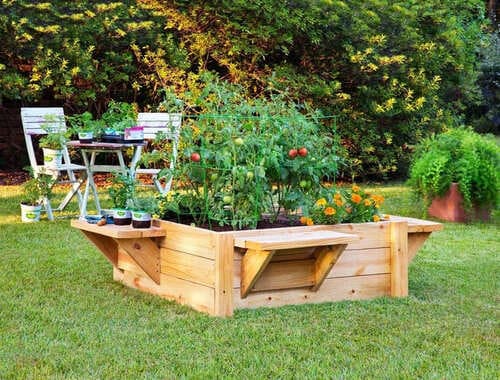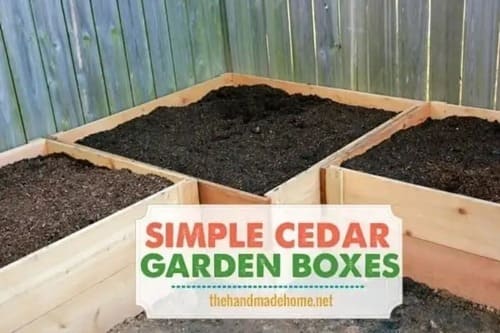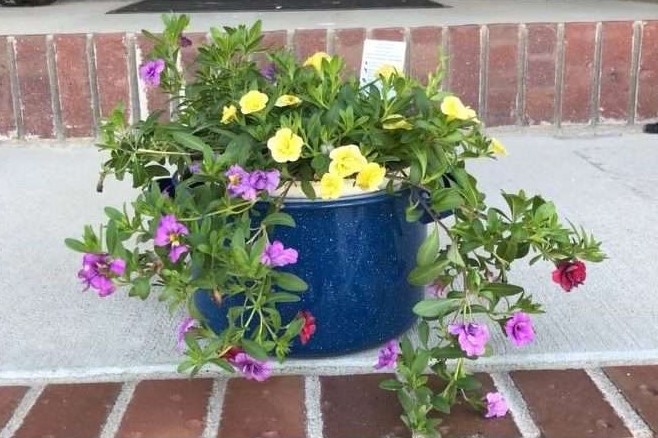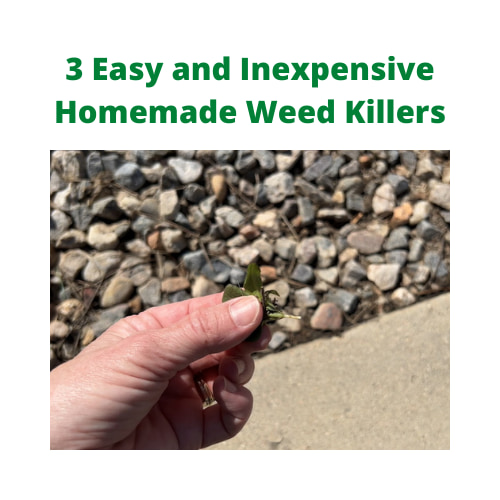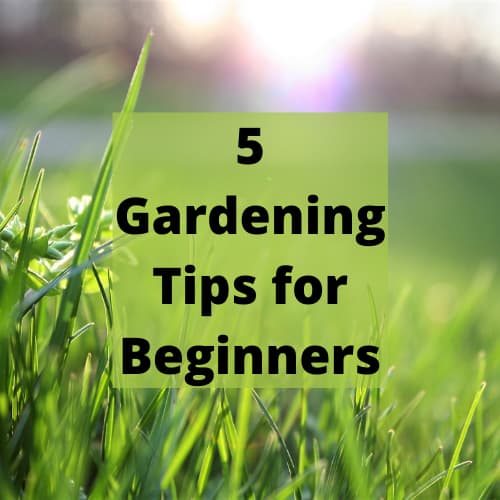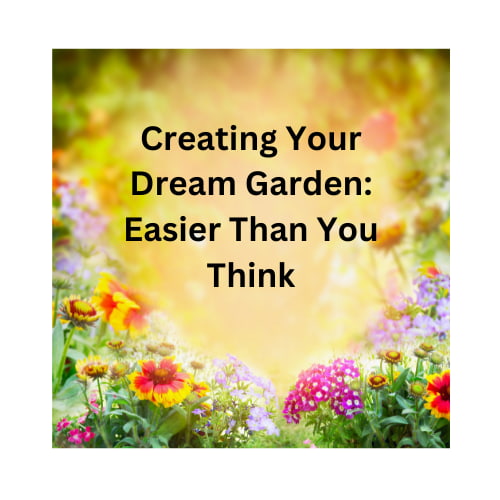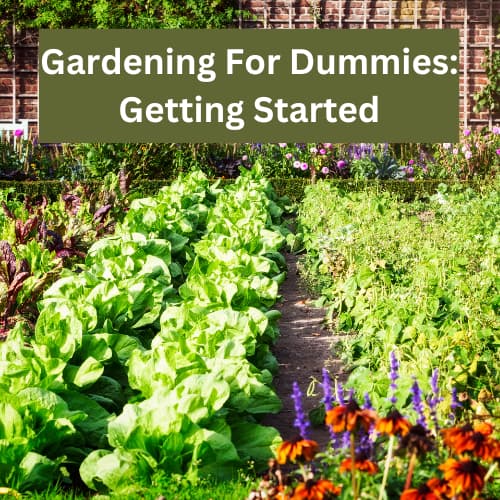Creative Raised Garden Bed Ideas to Transform Your Backyard
If you’re a gardening enthusiast or someone who simply enjoys spending time in their backyard, these raised garden bed ideas are about to become your new obsession! These elevated planters not only add a touch of beauty to your outdoor space but also offer multiple benefits that can significantly enhance your gardening experience.
This post may contain affiliate links, I earn from qualifying purchases at no extra cost to you. Click here for my disclosure policy
But why should you consider raised garden beds? These elevated planters offer numerous advantages over traditional in-ground gardening. They provide excellent soil quality, improved drainage, and increased control over growing conditions. Whether you dream of growing vibrant flowers, fresh herbs, or a bountiful vegetable harvest, raised garden beds offer a practical and efficient way to make your gardening dreams come true.
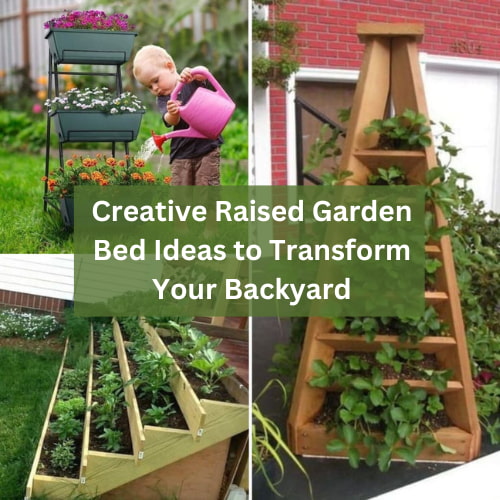
Benefits of Raised Garden Beds
Raised garden beds offer several benefits for gardeners. Here are some key advantages:
- Improved soil control: With raised beds, you have greater control over the soil quality and composition. You can fill the beds with a customized mix of soil, compost, and amendments, ensuring optimal conditions for plant growth. This is particularly advantageous if your native soil is of poor quality or if you have limited gardening space.
- Better drainage: Raised beds often have superior drainage compared to traditional garden beds. Excess water can easily flow out of the raised bed, preventing waterlogging and reducing the risk of root rot. This is especially beneficial in areas with heavy or clayey soil that tends to retain water.
- Enhanced soil warmth: Raised beds tend to warm up more quickly in the spring, allowing for earlier planting and extending the growing season. The elevated soil level absorbs and retains more heat from the sun, creating a favorable environment for plant growth.
- Reduced weed competition: Raised beds provide a physical barrier between your cultivated soil and the surrounding areas, reducing the likelihood of weed encroachment. The controlled environment makes it easier to manage and suppress weeds, saving you time and effort in maintenance.
- Improved accessibility: The raised height of the beds makes gardening more accessible and comfortable, especially for individuals with mobility issues or those who prefer not to bend over for extended periods. This accessibility also benefits children, allowing them to participate in gardening activities more easily.
- Pest control: Raised beds can help deter some pests, particularly those that crawl on the ground, such as slugs and snails. You can add physical barriers like mesh or netting around the beds to further protect your plants from pests. Additionally, it’s easier to implement and maintain pest control measures, such as companion planting or installing row covers, in a confined raised bed space.
- Aesthetically pleasing: Raised garden beds can add beauty and structure to your garden. They provide a neat and organized appearance, creating visually appealing focal points. You can choose from various materials and designs to match your garden style and personal preferences.
- Efficient use of space: Raised beds maximize your gardening space, allowing you to grow more plants in a smaller area. By using vertical gardening techniques or dividing the beds into sections, you can optimize your yield and cultivate a wider variety of plants.
- Soil erosion prevention: Raised beds can help prevent soil erosion, especially in sloped areas. The contained soil and the structure of the bed help retain soil particles during heavy rain, reducing the risk of erosion and nutrient loss.
- Easy maintenance: Raised beds generally require less maintenance than traditional gardens. The confined space makes tasks like watering, fertilizing, and harvesting more efficient. It’s also easier to monitor and manage plant health, detect and address issues promptly, and perform routine maintenance tasks.
These benefits make raised garden beds a popular choice for gardeners, whether they have limited space, poor soil conditions, physical limitations, or simply want to enhance their gardening experience.

General Raised Garden Bed Advice
Raised garden beds can be a fantastic addition to any garden, offering numerous advantages such as improved soil quality, better drainage, and easier maintenance. Here are some general tips and advice for raised garden beds:
- Location and sunlight: Choose a location that receives ample sunlight, usually at least six hours a day. Most vegetables and herbs thrive in full sun, so ensure your raised bed is placed accordingly.
- Bed size and height: Consider the size and height of your raised bed. The width of the bed should be around 3 to 4 feet, making it easy to reach across and tend to the plants. The height of the bed should be at least 8 to 12 inches, allowing for proper root development.
- Material selection: Raised beds can be constructed from various materials such as wood, stone, or brick. Cedar is a popular choice for wood beds due to its natural resistance to rot. Whichever material you choose, ensure it is safe, non-toxic, and durable.
- Soil quality: Fill your raised bed with high-quality soil mix, preferably a combination of compost, topsoil, and organic matter. This will provide the plants with essential nutrients and good drainage. Avoid using regular garden soil, as it tends to be heavy and may not drain well in raised beds.
- Irrigation and drainage: Install a suitable irrigation system to ensure consistent watering. Raised beds tend to drain more efficiently than traditional gardens, so make sure the soil retains moisture while allowing excess water to drain away.
- Crop selection and rotation: Plan your crops based on the available space and the amount of sunlight your garden bed receives. Practice crop rotation each year to prevent soil depletion and reduce the risk of pests and diseases.
- Weed control: Use mulch to suppress weeds and conserve soil moisture. Organic mulches such as straw or wood chips are excellent options. Regularly inspect and remove any weeds that manage to emerge.
- Planting density: Optimize the use of space by planting crops close together, but ensure they have enough room to grow without competing for resources. Follow spacing recommendations provided on seed packets or plant labels.
- Regular maintenance: Maintain your raised bed by regularly checking for pests, diseases, and nutrient deficiencies. Remove any dead or diseased plants promptly to prevent the spread of problems.
- Seasonal care: Adjust your gardening practices based on the changing seasons. In colder climates, consider adding a protective cover or cold frame to extend the growing season. In warmer climates, provide shade and adequate watering during hot summer months.
Remember that these are general guidelines, and it’s essential to consider your specific gardening zone, climate, and the plants you intend to grow when implementing these recommendations. Happy gardening in your raised beds!
In this article, I’ve selected a bunch of raised garden bed ideas to inspire and guide you in creating your own green haven. From classic designs with timeless charm to innovative and space-saving solutions, I’ve curated a huge range of ideas that will suit any preference and available space.
This post and photos may contain Amazon or other affiliate links. If you purchase something through any link, I may receive a small commission at no extra charge to you.
Classic Raised Garden Bed Designs
Traditional Wooden Raised Garden Bed Ideas
1. Raised Beds for Your Vegetable Garden
Create your own raised bed with ease! This step-by-step guide walks you through the process of building a simple raised bed from scratch, no expertise is needed.
2. Getting Started With Raised Bed Gardening
Whether you’re starting a raised bed garden or seeking to enhance your current crops, and you’re into podcasts, I’ve found you the perfect resource! It’s an hour dedicated to how Joe started his garden and general advice anyone building their own raised garden bed should know.
3. Elevated Wooden Garden Bed with Legs, 3 Tiers
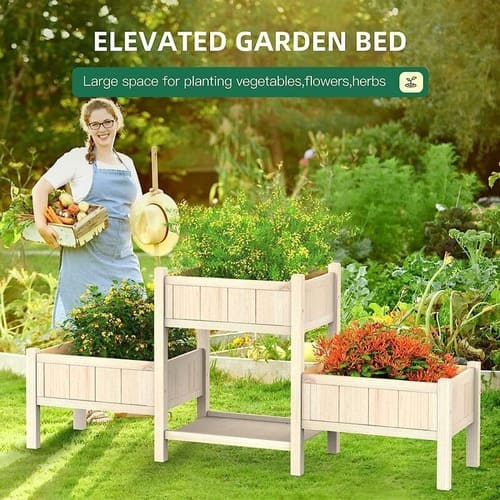
If you’re not into DIY or don’t have the time to spend on budling a garden bed, you can order one from Amazon! This 3-tier design is beautiful, and it’s perfect for growing:
- Flowers
- Herb
- Vegetables
- Fruits
4. Inexpensive Raised Garden Bed with Furring Strips
What if there’s a way to make your own wooden raised garden beds but not spend all your funds on wooden material? Well, there is! Read more about the project here – the instructions are detailed and uncomplicated!
Concrete Block Raised Garden Beds
5. How to Build a Concrete Blocks Raised Garden Bed
Transform your garden with a stylish cinder block raised bed that’s easy to build. Say goodbye to back pain and hello to the joys of gardening! In this project, Monty Don and Chris Beardshaw show us how to use breeze blocks for a durable raised garden structure.
6. Beginner’s Raised Garden Bed Ideas That Work
No, you don’t need to be a seasoned gardener or a contractor to have a beautiful and bountiful raised garden in your backyard! Here’s how!
7. Make a Concrete Block Raised Bed
If you’re more into videos, here’s one that will teach you everything you need to know about building your own concrete block garden beds!
Stone or Brick Raised Garden Beds
8. Natural Stone Raised Garden Bed
This beautiful natural stone raised garden bed would be a joy for the eyes every time you go out on your patio, wouldn’t it? I love DIY projects like this one!
9. Simple Brick Raised Garden Bed Idea
Got some old bricks you’re looking to reuse in the garden? Then, get ready with your compost and manure because, with this step-by-step tutorial, your new bricks raised garden bed will be done in no time!
Space-Saving Raised Garden Beds
Vertical Garden Bed Ideas
10. Staircase Vertical Planter Idea
Looking to save space and maximize yields? Check out this fantastic staircase planter!
11. Elevated Planter Garden Box with a Drainage Plug

If you’re not feeling like starting another big garden DIY project, you can order a ready-for-you elevated planter garden box with a drainage plug! It’s quick and easy to assemble, and you’ll be growing strawberries, radishes, and even carrots on your deck in no time!
12. DIY Vertical Planter
Your back patio NEEDS this DIY vertical planter, and you know it! These are perfect for growing herbs like basil and parsley or just a place for these beautiful flowers you just got the seeds for.
13. Vertical Garden Tower
No longer can the lack of room be an excuse for not growing edibles. Even the tiniest patch of a yard can provide you with a surprising amount of gardening space when you think vertical. This vertical garden tower is just what you were looking for.
Tiered Raised Garden Bed Ideas
14. DIY Tiered Raised Garden Bed with Free Plans
If you’re looking for plans on how to build a tiered raised garden bed, I just found you the perfect ones!
15. Strawberry Pyramid Planter
This is one of my favorite raised garden bed designs ever – a pyramid planter! It looks so pretty and easy to manage – no weeds and pests are also kept to a minimum. Perfect solution if you are not a fan of traditional gardens, too.
Hanging Raised Garden Beds
16. Hanging Strawberry Garden
Did you know that the only thing you need to do to grow your own strawberries is just to repurpose a pipe? Well, I didn’t know either, but these look great!
17. Hanging Herb Garden: DIY Guide and Benefits
Upgrade your home this summer with a hanging herb garden. This cost-effective project is ideal for any size space, doesn’t matter big or small. So, if you believe you don’t have room for an indoor herb garden, think again! Get ready to gather the necessary supplies and get ready to create!
18. Upside-Down Tomatoes
If you think about a tomato plant, what do you imagine? A tall, big stem with fruit? Yes, but did you know you can actually grow tomatoes upside-down? Such a fun project to try, especially if you have kids!
Unique and Creative Raised Garden Bed Designs
Raised Garden Beds From Repurposed Materials
19. Raised Garden Bed From Old Cedar Fence
Reusing old fence in the garden? What a clever idea! Check out how they did it here.
20. “Woven” Raised Garden Beds With Pruned Branches
If you’ve happened to just cleaned your yard from all of the overgrown shrubs and branches, you might want to consider making “woven” raised garden beds with them. This is an easy and cheap way to make your raised beds, and you end up reusing your waste in a great way.
21. Raised Bed Tire Garden
Raising tires on rails:
- Offers a solution for uneven ground
- Creates additional space, and
- Protects crops from some pests and animals
Just don’t forget to provide proper watering either manually or by using a drip irrigation system. Raised garden beds tend to dry out quicker compared to traditional gardens.
22. Double Stacked Tire Flower Gardening Bed
Wondering where to throw away those old tires you just changed? You should make a double-stacked tire flower gardening bed! It looks impressive and adds up to your gardening space, too!
Keyhole Garden Beds
23. Keyhole Garden Using Reclaimed Materials
Grab some old cinder blocks and bricks, and easily create a magical place in your garden! Just like this one!
24. Permaculture Keyhole Garden Beds
Don’t you just love how these permaculture keyhole garden beds can be customized to any size or shape?
Specialty Raised Gardens
25. Raised Bed Garden From Roofing Sheet Metal
Roofing sheet metal makes excellent raised bed garden beds, it appears! Just look how good these turn out!
26. Cheap and Easy Propylene Silt Fencing Raised Garden Beds
If you want raised garden beds on the cheap, with simple maintenance, and which you can easily disassemble or move after some time, you should look to explore propylene silt fencing garden beds.
27. How to Build a Raised Bed with Benches
Craft a raised bed that not only raises your plants off the ground but also has benches on all four sides. Perfect for people with back or knee pain.
Herb or Flower-Specific Raised Beds
28. Rustic Wheelbarrow Herb Garden
Reusing an old rustic wheelbarrow to grow herbs? What a brilliant idea!
29. Galvanized Steel Planter Box

Experience the joy of homegrown delights with a galvanized raised garden bed With these planter boxes you effortlessly kickstart your:
- Vegetable garden
- Flower bed
- Herb paradise
Say goodbye to store-bought produce and embrace the joy of growing your own produce. Order yours now!
30. How to Build a Garden Box – A Simple Tutorial
Using rot-resistant woods is a must in raised garden bed building. They took it into consideration in this fun project by using cedar wood.
Small Spaces and Balconies Raised Garden Beds
31. Vertical Elevated Garden Beds Planter Box with Removable Tray

These vertical garden planter boxes are fantastic for:
- Balcony
- Courtyard
- Garden, or
- Indoors
Its sturdy metal frame takes a little floor space but provides you with plenty of gardening space!
32. DIY Pallet Garden – Easy Vertical Gardening
Check out this simple tutorial about building your own vertical pallet garden, even if you have limited space in your backyard or balcony.
33. DIY Ceramic Pot Vertical Garden
If you’re even a little like me, you love simple and beautiful projects. That’s why I know you’ll love this DIY ceramic pot vertical garden! So easy, yet so functional!
Raised Garden Beds for Wheelchair Accessibility
34. Wheelchair-Accessible Raised Planter Beds
I found a video that guides you through the whole step-by-step process of how to make your own wheelchair-accessible raised planter beds. These folks built those for a local senior living center for the residents to grow flowers and herbs.
35. Wheelchair Accessible Gardens by Gardens for Humanity
These gorgeous wheelchair-accessible gardens are at Sedona Winds Assisted Living in Sedona, AZ. Even though you wouldn’t necessarily expect a garden in an assisted living facility, Gardens for Humanity built those there, and the residents love it!
47 Raised Garden Bed Ideas – Quick list
- Tiered raised garden bed with cascading plants
- Circular raised garden bed with a central focal point
- Spiral-shaped raised garden bed
- Keyhole garden bed with a composting center
- L-shaped raised garden bed for corner spaces
- Herb-specific raised garden bed with labeled sections
- Raised bed with trellis for vining plants like tomatoes or beans
- Vertical pallet garden with multiple tiers
- Raised bed garden with integrated seating or benches
- Colorful raised garden bed using painted or stained wood
- Square foot gardening raised bed with dividers for precise spacing
- Rock garden raised bed with succulents and alpine plants
- Raised garden bed with built-in irrigation system
- Raised bed with removable covers for season extension
- Raised bed on wheels for easy mobility
- A raised bed made from recycled materials like old tires or pallets
- Raised bed with integrated storage for gardening tools
- Raised bed with a hoop house for year-round gardening
- Raised bed with built-in cold frames for early spring planting
- Raised bed with a built-in trellis archway for an entrance effect
- Raised bed with integrated seating and a pergola for shade
- Raised bed with decorative metal or wrought iron corners
- Raised bed designed in the shape of an animal or geometric pattern
- Vertical herb wall with multiple tiers of planters
- Raised bed with integrated insect netting for pest control
- Hexagonal raised garden bed for a unique shape
- Raised bed with a water feature or small pond
- Raised bed with built-in herb spiral or snail-shaped design
- Tiered raised bed with a cascading waterfall effect using plants
- Raised bed designed in the shape of a specific letter or symbol
- Raised bed with integrated seating and a fire pit for a cozy ambiance
- Raised bed with built-in lighting for nighttime gardening
- Raised bed with a built-in greenhouse for seed starting
- Vertical strawberry tower with multiple planting pockets
- Raised bed with built-in vertical herb or flower planter pockets
- Spiral herb garden in a raised bed design
- Raised bed with staggered heights for a terraced effect
- Tiered raised bed with different layers for specific plant types
- Raised bed with a built-in rainwater collection system
- Raised bed with a built-in trellis for privacy screening
- Raised bed with integrated seating and a pergola for climbing plants
- Zigzag pattern raised garden bed for a visually interesting design
- Raised bed with built-in shelves for additional storage or display
- Vertical vegetable garden with hanging baskets or planters
- Raised bed designed to mimic a specific architectural style
- Tiered raised bed with cascading herbs or flowers in different colors
- Raised bed with a mosaic or decorative pattern using tiles or stones
Raised Garden Bed Ideas Q&A
How much does it cost to build your own raised bed?
According to the LawnStarter.com:
The average cost for a raised garden bed kit is $145.48, with a typical range from $104.18 to $210.46. See Pricing in Your Area The average cost for a raised garden bed kit is $145.48, with a typical range between $104.18 and $210.46.
via the LawnStarter.com
However, since you’re into DIY and probably already have some materials lying around the house waiting to be repurposed, you might be able to decrease the cost more.
Is it OK to use treated wood for raised beds? What kind of wood should be used for raised beds?
If you decide to build your own wooden raised garden beds, keep in mind that you can use different types of trees to construct them, like:
via ThrivingYard.com
- Pressure-treated (Yes, really)
- Cedar
- Cypress
- Black Locust
- Pine
- Oak
- Redwood
However, when you’re using pressure-treated lumber, keep in mind:
- Not all pressure-treated woods are safe for use because of harmful chemicals (look for ones made after 2004)
- To have your soil tested regularly for heavy metals
- Use plastic sheeting and/or hardware cloth on the inside of your raised garden beds to avoid direct contact between the wood and the soil
- Pressure-treated lumber is not acceptable for organic growers under the USDA Organic guidelines
Raised Garden Bed Ideas Q & A

What wood should not be used in a raised garden bed?
You should not use the following woods and materials in a raised garden bed:
- Pressure-treated woods made before 2004
- Tires
- Electricity/Utility Poles
- Railroad Ties
- Cinder Blocks
- Wood pallets with Methyl Bromide (MB pallets), colored pallets, and old European pallets
How deep should a raised bed garden be?
The ideal depth for a raised bed garden depends on the types of plants you want to grow. In general, a depth of 6 to 12 inches (15 to 30 centimeters) is suitable for most vegetables and herbs, like:
- Spinach
- Chives
- Oregano
- Rosemary
- Salad greens
- Lettuce
- Thyme
- Cilantro
- Onions
However, if you plan to grow root crops like carrots or potatoes, consider a deeper bed of 12 to 18 inches (30 to 60 centimeters) to accommodate their growth. Remember, deeper beds also provide better drainage and can prevent soil compaction.
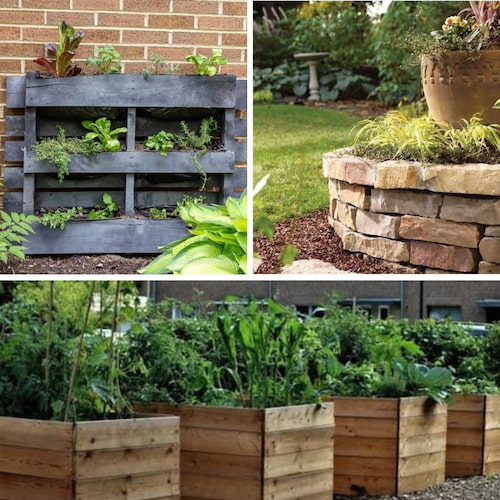
What is the cheapest way to make raised beds?
To build your raised garden beds in the cheapest way possible, think about:
- Using old or reclaimed materials, like old wooden pallets, fences, or other discarded lumber.
- Another way is using straw bales as the bed walls, which not only provides an inexpensive solution but also acts as a natural mulch as it decomposes over time and provides the soil with additional nutrients.
- Sourcing locally available materials like rocks or logs can help you save costs, too.
Check out the creative raised garden beds list with ideas above in this post. I am sure you’ll find inspiration.
What do I put on the bottom of a raised garden bed?
When you set up your raised garden bed, it’s important to start with a suitable foundation:
- Option 1 is to use landscape fabric to block weeds and grass from growing
- Another way is to use cardboard, which serves a similar purpose and can is an eco-friendly choice, but it decomposes quite fast
Both materials help in keeping your garden bed a weed-free environment while allowing water to drain through. Another smart thing to do is to incorporate a layer of coarse gravel or small rocks at the bottom. They help in drainage and prevent soil compaction.
What is the best filler for raised garden beds?
When filling a raised garden bed, you’ll want to create a soil mix that provides good drainage, nutrient content, and water retention. Here are some possible materials you can use as fillers or components of your raised garden bed soil mix:
- Compost: Compost is a fantastic organic filler that adds nutrients, improves soil structure, and enhances moisture retention. It also helps promote beneficial microbial activity in the soil. You can make your own compost or purchase it from a local garden center.
- Topsoil: Good quality topsoil forms the base of your raised bed. It provides a solid foundation for plants and contributes to the overall nutrient content. Look for a well-balanced, loamy topsoil.
- Peat moss: Peat moss helps retain moisture in the soil while providing a light, fluffy texture. It improves aeration and water retention capabilities, particularly in sandy soils. Keep in mind that peat moss is not a sustainable resource, so consider alternatives like coconut coir if environmental concerns arise.
- Vermiculite: Vermiculite is a mineral that helps improve water retention in the soil while enhancing aeration. It also aids in nutrient retention. Adding vermiculite can be especially beneficial for plants that prefer moist soil.
- Perlite: Perlite is a lightweight volcanic rock that improves drainage and aeration in the soil mix. It prevents compaction, promotes root development, and allows excess water to drain away effectively.
- Organic matter: Incorporating organic matter, such as well-rotted manure or leaf compost, can enrich the soil with nutrients and enhance its structure. Organic matter improves drainage, encourages beneficial microbial activity, and adds fertility to the soil.
- Coconut coir: Coconut coir is an eco-friendly alternative to peat moss. It retains moisture, improves soil structure, and enhances nutrient retention. It comes in compressed blocks and can be rehydrated before use.
Remember to mix these components in appropriate proportions to achieve the desired texture, fertility, and drainage for your raised bed. The specific ratios will depend on your plants’ needs and your garden’s conditions. Consider conducting a soil test to determine any necessary amendments for your particular garden bed.
